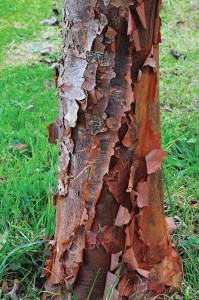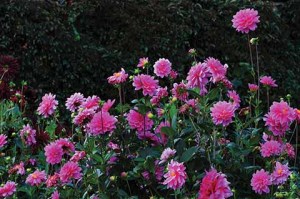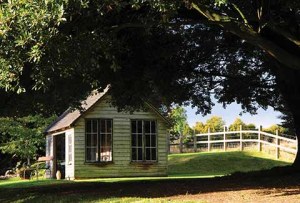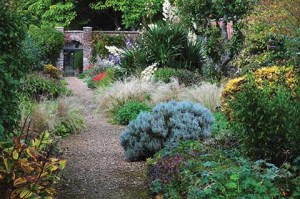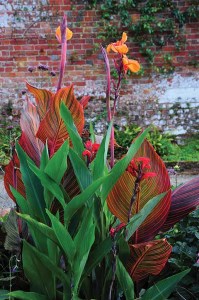A Dorset Garden: Edmonsham House
Susy and Colin Varndell visit a garden full of texture and colour
Published in September ’17
Edmondsham House, on the southern edge of Cranborne Chase, is a charming Tudor manor house with some Georgian additions, which nestles harmoniously and unpretentiously in its setting. It is elegantly simple yet completely captivating. The house is approached via a winding driveway which meanders through spacious lawns and mature specimen trees. It has six acres of landscaped gardens, including a Victorian walled garden.
This hard landscaping was created many years ago. The mature hedges undulate gently from area to area, making a shapely backdrop to much of the planting, as well as giving the garden a relaxed and informal feel. The garden has a chalky subsoil, which affects what may be grown here, and is cultivated on organic principles. In autumn the interest is provided by tree foliage and late flowering hardy plants.
At the rear of the house there is a shady corner with a north-facing wall. This paved area has a central bed planted with a selection of Roscoea, an unusual group of plants in the ginger family with flowers that look like something between an iris and an orchid. On the wall is a fine specimen of Hydrangea anomala subsp. Petiolaris, which bears large, pretty, white lace-cap flowers in early summer. It is a useful climber for it is happy to live on a north-facing wall.
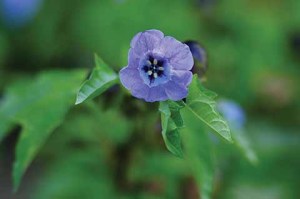
The attractive but unremarkable Nicandra physalodes (otherwise known as Shoo-fly) self-seeds at will and is said to deter whitefly
Passing through to the main lawn, one cannot help but notice an elegantly shaped pot containing the striking Fuchsia ‘Thalia’. It is not hardy but its presence, with its clusters of bright orange-red flowers, cannot be missed, especially in this shady corner. The large Cedrus atlantica was planted in 1848 and creates a majestic and imposing statement on the west lawn. The lawn itself is bordered by evergreen oaks, Quercus ilex. The attractive summer house nestles comfortably on the shady grass bank. The incredible copper beech tree, which is at least two hundred years old, has beautifully sculptured and knobbly roots which are adorned with hardy cyclamen in late summer
and autumn.
Moving seamlessly to the semi-circular double earthwork area, one stands in a level spot with sloping grassy banks surrounding it. This is said to have been a cock-fighting arena in the Middle Ages. This unusual feature is surrounded by a mature double yew hedge. In the Dell area of the garden there is a ‘winterborne pond’ which dries up in the summer. The tree with the reddish bark is the Dawn Redwood, Metasequoia glyptostroboides, which was once thought to be extinct and known only in fossil form. This particular specimen was planted in 1967. The weeping willow is an attractive feature, but its origins are far less ancient, but now perhaps as historically important – a purchase from Woolworths!
The Acer griseum, a lovely, slow-growing, medium-sized tree, is grown for its autumn colour, when the leaves turn brilliant shades of orange and red. In addition the bark, which is the colour of cinnamon, peels away naturally in thin layers. Its common name is paper bark maple. Alongside is a black walnut, Juglans nigra, which grows fast on its preferred chalky soil.
The exotic border was originally a rose bed, but due to the shallow soil it never thrived, and it is now stuffed with interesting plants. There are tender perennials here along with grasses, which appear very happy in these conditions.
The ornamental red ginger, Hedychium greenii, with its fragrant, erect, trumpet-shaped flowers and maroon stems, has a lovely arching appearance. It would be easy to miss the Indian Bean tree or Catalpa bignonioides, which has slender, long, bean-like seed pods which hang down in autumn. Quite enchanting. Although there are many other interesting plants, it is time to visit the fantastic organic walled and kitchen garden, which has been managed organically since 1984, and has been ‘no dig’ since 2003.
The long herbaceous border is planted to provide an extended season of interest, but there is plenty to enjoy and marvel at in addition to this spectacular feast. The border is full of peonies, asters, oriental poppies, delphiniums, echinops and more. The yucca was particularly successful last year, having seventeen flower spikes.
The kitchen garden also has a wide range of flowering plants that mingle with vegetables to encourage beneficial insects, which in turn help protect against unwanted pests. The intriguing climber, Ampelopsis brevipedunculata, bears unremarkable green flowers in the summer but develops pinkish purple fruit that turns clear blue and turquoise in the autumn, appearing just like porcelain. A real gem, especially as it is hardy, except in the cruellest of winter weather. Nicandra physalodes (otherwise known as Shoo-fly) self-seeds at will and is said to deter whitefly, but encourages hoverflies: another gem in the
organic garden.
Beautiful hazel arches, constructed annually from coppiced woodlands on the estate, support runner beans and the ornamental quick-growing annual climber, Mina lobata. Otherwise known as Ipomoea lobata, it has attractive foliage which is followed by cascades of flowers that fade with age, starting flame-red at the tip and fading to cream. A long flowering period is an added bonus and it looks spectacular for three to four months.
Another interesting plant is a cushion type of wallflower, Erysimum ‘Moonlight’, which is a tactile, clump-forming, semi-evergreen perennial. Wallflowers are nectar rich-plants which encourage beneficial wildlife such as ladybirds, lacewings and hoverflies into the garden.
On the far side of the walled garden there is a composting area with a Russian comfrey bed. Organic liquid compost is made from the leaves, which, due to its high levels of all the essential nutrients for plant growth, is a valuable liquid feed.
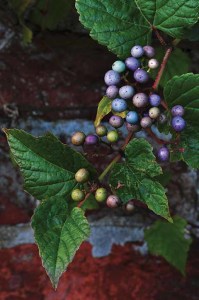
The intriguing climber, Ampelopsis brevipedunculata, which develops pinkish-purple fruit that turn clear blue and turquoise in the autumn and looks just like porcelain
Go and enjoy the space and tranquillity of the garden. Savour the unpretentious yet captivating atmosphere and be prepared to be enchanted by its informal formality. This special piece of Dorset, with its lack of commercial activity and conventions, is one of its charms, along with the wide range of wildlife which obviously enjoys the surroundings as much as the humans who visit.


